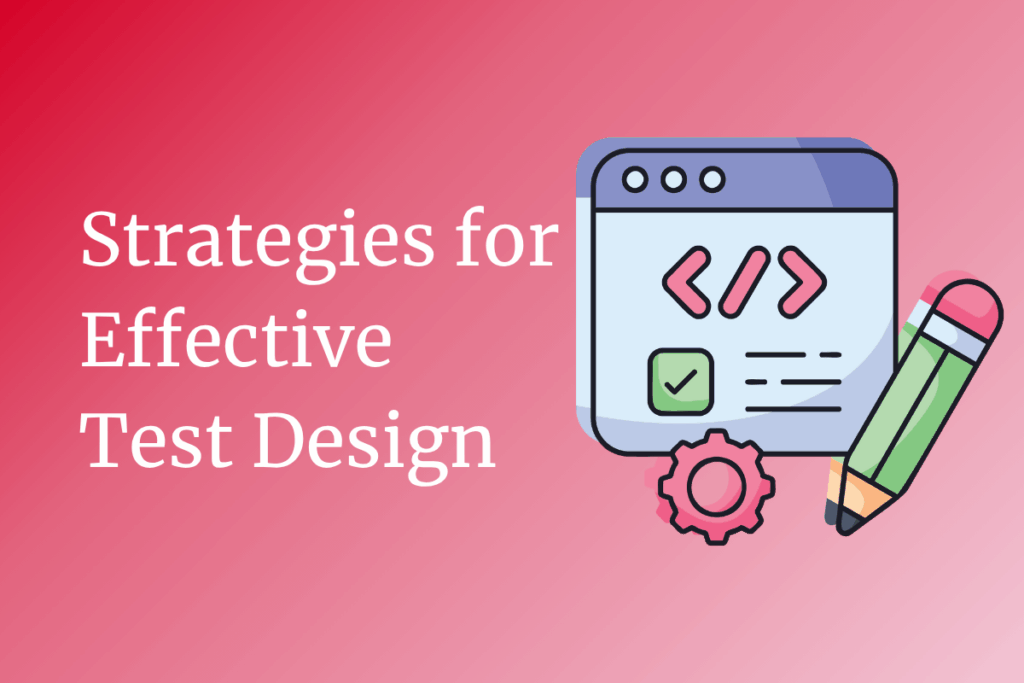In a world where software underpins nearly every aspect of our lives, from communication to commerce, have you ever stopped to consider what truly separates a seamless, reliable application from one riddled with frustrating glitches? The answer lies in the craft of software quality assurance. Delivering high-quality, reliable applications isn’t just a competitive edge; it’s the foundation of user trust, brand reputation, and ultimately, business success.
As software systems grow increasingly complex, the need for innovative strategies in test case design and execution has become more pronounced. This topic explores various methodologies that enhance the quality of software testing, particularly through the integration of artificial intelligence (AI) and genetic algorithms, which offer promising solutions to traditional challenges in test case management.
Understanding Test Design Fundamentals
Test design is the systematic process of creating test cases, scenarios, and procedures that validate software functionality against requirements. It involves analyzing requirements, identifying test conditions, and designing test cases that provide maximum coverage with optimal efficiency. Modern test design goes beyond basic functional testing to encompass performance, security, usability, and compatibility testing across multiple platforms and devices. According to industry research, well-designed test cases can reduce defect rates by up to 40% while improving overall software quality.
The foundation of effective test design lies in understanding the application under test, its business requirements, and the potential risks associated with software failures. This understanding enables testers to prioritize test cases based on business impact and technical complexity, ensuring that critical functionalities receive appropriate attention during the testing process.
Foundations of Excellence: Strategies for Effective Test Design
Effective test design serves as the bedrock of a robust testing strategy, ensuring that all testing efforts are precisely targeted, comprehensively cover critical areas, and are executed with maximum efficiency. It is about meticulously setting the stage for the early identification of defects and the thorough validation of software against its intended purpose and user requirements.
Defining Clear Objectives and Scope for Impactful Testing
A clear, well-articulated test strategy and a precisely defined scope form the “backbone” of any successful testing endeavor. This foundational step involves a deep understanding of the project requirements, overarching business goals, and anticipated user expectations, ensuring that all testing activities are accurately aligned with these objectives.
Key elements in this initial phase include clear test objectives, such as ensuring core functionality, optimal performance, robust security, and superior usability. For example, functional testing verifies that the software operates as specified, while performance testing evaluates efficiency under various load conditions. The testing scope defines what is included and excluded, helping to manage stakeholder expectations and allocate resources effectively. Identifying high-risk areas or features prone to regression is also essential, allowing for the prioritization of testing on critical components to ensure their stability.
Essential Test Design Techniques: A Comprehensive Toolkit
Test design techniques are systematic and proven approaches used to create effective test cases. They involve identifying various input combinations and outputs to thoroughly evaluate software system functionality. These techniques are crucial for achieving comprehensive test coverage, enhancing defect detection capabilities, and ultimately streamlining the entire testing process.
These techniques are broadly categorized into three main types:
Specification-Based (Black-Box) Techniques
These techniques focus on the software’s external behavior and functional requirements, without any knowledge of its internal code structure.
Equivalence Partitioning (EP): This technique divides input data into distinct classes where similar behavior is expected, significantly reducing the number of required test cases while maintaining broad coverage. For example, for a numerical input field requiring a number between 1 and 100, EP would involve testing one value from partitions like 1-50, 51-100, and values outside the range, such as -1 or 101.
Boundary Value Analysis (BVA): This technique specifically tests values at the extreme boundaries of both input and output ranges, as a significant number of errors are known to occur at these edges. For instance, for an input requiring a number between 1 and 10, BVA would test values like 0, 1, 2, 9, 10, and 11.
Decision Table Testing: This method utilizes a tabular format to represent complex decision logic and corresponding test cases, ensuring that all possible conditions and their outcomes are thoroughly tested. An example would be a program offering discounts based on customer type and total amount spent, where a decision table lists all possible combinations and the corresponding applicable discount.
State Transition Testing: This technique validates system behavior based on changes in its states, ensuring the system transitions correctly between different states. This is particularly useful for systems with defined workflows. For example, an e-commerce website might display states such as “logged out,” “logged in,” “cart empty,” and “order placed,” with transitions triggered by user actions.
Use Case Testing: This approach focuses on user-centric scenarios by simulating real-world user interactions to ensure the system functions as expected in various contexts. For instance, a “student enrolling in a course” on an academic website would involve test cases simulating the entire enrollment process from the student’s perspective.
Structure-Based (White-Box) Techniques
These techniques involve testing based on the internal structure, logic, and components of the code.
Statement Coverage: Ensures that every executable statement in the code is executed at least once during testing.
Branch Coverage (Decision Coverage): Guarantees that all branches of decision points (e.g., if-else statements) are executed at least once for both true and false outcomes.
Path Coverage: Aims to ensure that every possible execution path through the code is exercised at least once.
Experience-Based Techniques: These techniques heavily rely on the tester’s accumulated experience, specialized knowledge, and intuitive understanding of potential error-prone areas.
Error Guessing: Testers design test cases based on their knowledge and intuition about where errors are likely to occur.
Exploratory Testing: Testers actively explore the application without predefined test cases, using their knowledge and intuition to uncover defects.
Key elements in this initial phase include clear test objectives, such as ensuring core functionality, optimal performance, robust security, and superior usability. For example, functional testing verifies that the software operates as specified, while performance testing evaluates efficiency under various load conditions. The testing scope defines what is included and excluded, helping to manage stakeholder expectations and allocate resources effectively. Identifying high-risk areas or features prone to regression is also essential, allowing for the prioritization of testing on critical components to ensure their stability.
Crafting Robust Test Cases and Data for Diverse Scenarios
Test cases are meticulously detailed instructions that guide the execution of a test. They typically include essential information such as a unique ID, a concise summary, a sequence of actionable steps, and details about the required test environment. These structured test cases are considered the core artifacts of effective test design.
Test Data Management (TDM) is a critical and often underestimated component for achieving effective and reliable software testing. Its primary goal is to ensure that the data used for testing is accurate, relevant, up-to-date, and precisely reflects the real-world conditions in which the software or system will ultimately be used. Releasing unstable software due to inadequate testing data can severely tarnish a company’s reputation. Just as a car requires fuel, an application requires appropriate and sufficient data to function and be thoroughly tested. TDM encompasses a range of crucial activities, including identifying and selecting the most appropriate data for testing, meticulously preparing that data for use, and then effectively managing and storing it throughout the entire testing process.
Key strategies for TDM include:
Data Discovery: This involves systematically identifying where privacy-sensitive information is located within databases and uncovering any data anomalies or pollution.
Data Masking/Anonymization: A critical strategy involving the obfuscation or anonymization of privacy-sensitive data to ensure compliance with stringent data protection rules and regulations.
Synthetic Data Generation: This involves creating artificial but highly representative data, which is particularly useful when production data is unavailable, insufficient, or too sensitive to use directly.
Data Subsetting: This strategy enables the creation and deployment of smaller, highly relevant subsets of data to various test environments, thereby significantly enhancing flexibility and reducing the need for large-scale data storage.
Test Data Virtualization: This involves creating virtual copies of databases that are isolated from actual production systems, providing a safe and controlled environment for testing without impacting source data.
Test Data Provisioning: This focuses on facilitating the easy, on-demand distribution and refreshing of specific test data sets to testing teams.
Test Data Automation: Automating the activities of data generation, masking, and provisioning to enhance the overall efficiency and effectiveness of the data management process.
Implementing robust Test Data Management (TDM) strategies offers key benefits, including compliance with data anonymization laws, faster time-to-market by minimizing delays, and enhanced testing efficiency. As data complexity increases and privacy regulations tighten, relying on unmasked production data for testing is no longer feasible. “The right data” must now be secure, compliant, and relevant. Neglecting advanced TDM strategies can lead to legal penalties, data breaches, and delays in software development. Concepts such as “self-serve subsetting” and “entity-based provisioning” aim to democratize data access for testers while ensuring control and compliance, presenting both technical and organizational challenges.
Driving Quality Forward: Strategic Test Execution Methodologies
Once tests have been meticulously designed, their effective and efficient execution becomes the pivotal factor determining the overall success of the quality assurance process. This phase involves selecting and applying appropriate testing methodologies, leveraging the power of automation, and expertly managing the lifecycle of defects and test data.
Navigating the Testing Landscape: Functional and Non-Functional Approaches
Software testing is a multi-faceted discipline involving various stages and types of testing, ranging from early-stage unit tests to final user acceptance testing. Testing methodologies serve as strategic approaches to ensure that an application behaves and looks as expected across diverse operating environments and platforms.
Functional Testing primarily verifies that the software behaves precisely as expected, based on its defined business requirements and use cases.
- Unit Testing: This is the first level of testing, typically performed by developers. It ensures that individual code components or modules are functional and work as designed. Unit testing is crucial for early issue detection and significantly simplifies the debugging process.
- Integration Testing: After individual units are thoroughly tested, they are integrated to form larger modules or components designed to perform specific tasks. Integration testing then verifies these integrated groups to ensure seamless interactions and expected behavior between units, often framed by real-world user scenarios.
- System Testing: This is a black-box testing method used to evaluate the completed and fully integrated system as a whole. Its purpose is to ensure that the entire system meets all specified requirements. A separate, independent testing team typically conducts this type of testing before the product is released to production.
- Acceptance Testing: As the final phase of functional testing, acceptance testing assesses whether the software is truly ready for delivery. It ensures that the product fully complies with all original business criteria and effectively meets the end-user’s needs. This often involves both internal QA testing and external beta testing with actual end-users to gather real feedback and address any final usability concerns.
Non-functional testing focuses on the operational aspects and quality attributes of software that extend beyond basic functionality.
- Performance Testing: Determines how an application behaves under various conditions, assessing its responsiveness and stability in real-world user scenarios.
- Security Testing: Probes for vulnerabilities and weaknesses to ensure that information and data within the system are protected from unauthorized access or loss.
- Usability Testing: Measures the application’s ease of use and user-friendliness from the end-user’s perspective, often performed during system or acceptance testing.
- Compatibility Testing: Checks how the application or software performs across different operating systems, platforms, browsers, and various configuration settings to ensure consistent functionality.
The growing prominence of “shift-left testing” is not merely a trend; it is a strategic response to the increasing costs of fixing defects later in the development cycle or post-release. By incorporating unit and integration testing earlier and involving developers in quality assurance, organizations can reduce rework, minimize delays, and cut costs. This approach transforms testing from a reactive process to a proactive activity throughout the development lifecycle, requiring changes in organizational structure and team collaboration. It blurs the lines between development and QA, promoting shared responsibility for quality. Additionally, it emphasizes the need for automated testing at lower levels, as manual testing becomes inefficient. The success of agile and DevOps practices heavily relies on adopting this shift-left philosophy for improved efficiency and cost-effectiveness in software delivery.
The Power of Automation: Best Practices for Efficient Execution
Test automation plays a pivotal role in modern software development, enabling the rapid execution of a large number of tests, which is particularly valuable in large and complex projects. It significantly enhances efficiency, improves reliability, and ensures consistency in testing, thereby freeing up human testers to focus on more complex, exploratory, and intuitive tasks.
Automated regression testing is essential for large-scale, repetitive testing. It ensures that existing software functionalities remain intact and bug-free after code changes, preventing unintended defects. Automation allows tests to be run with every code change, which is crucial for complex, frequently updated software systems. Beyond cost savings, automation is vital for scaling Agile and DevOps methodologies. Without it, the increasing volume of regression tests could impede continuous delivery and rapid release cycles. Therefore, automation is the engine driving continuous delivery, enabling organizations to maintain both velocity and quality. Strategic investment in test automation transforms the entire software development lifecycle, facilitating rapid innovation and enhancing market responsiveness. Organizations that neglect comprehensive automation risk falling behind competitors, leading to slower releases and higher defect rates. The benefits of “24/7 operation” and “faster releases” highlight this important strategic shift.
Streamlining Quality: Defect and Test Data Management
Defect management is a systematic and structured process designed to identify, document, prioritize, track, and ultimately resolve issues (defects, bugs, glitches) throughout the entire software development lifecycle. Its overarching goal is to ensure that the software consistently meets predefined quality standards before it reaches end-users.
Key best practices include early defect prevention (e.g., code reviews, static code analysis), comprehensive testing across all stages, extensive use of test automation, seamless CI/CD integration, fostering strong collaboration, maintaining clear defect documentation, effective tracking, intelligent prioritization based on impact, continuous monitoring, thorough root cause analysis, utilizing metrics and reporting, conducting defect retrospectives, and promoting knowledge sharing. Effective defect management leads to improved software quality, enhanced user satisfaction, a more efficient development process, significant cost savings (primarily through early detection), accurate tracking and reporting, continuous process improvement, better team collaboration, and enhanced customer retention.
The AI Revolution: Transforming Test Design and Execution
Artificial Intelligence (AI) and Machine Learning (ML) are no longer merely buzzwords in the realm of software testing; they represent powerful, transformative tools that are fundamentally reshaping how tests are designed, executed, and maintained. These technologies are driving unprecedented levels of efficiency, accuracy, and insightful analysis within the quality assurance process.
AI’s Role in Intelligent Test Case Generation and Prioritization
AI and ML are revolutionizing the creation of test cases by automating this traditionally manual and labor-intensive process. This automation significantly reduces human effort while dramatically improving both the accuracy and comprehensive coverage of test suites.
AI systems analyze inputs such as application requirements and historical data, utilizing Natural Language Processing (NLP) to extract key information. By identifying data patterns, AI can predict test scenarios, including critical edge cases that human testers might overlook. Machine Learning algorithms continuously improve test precision, efficiency, and effectiveness, leading to enhanced test coverage and cost reductions during the testing phase.
AI can dynamically prioritize test cases based on factors such as historical defect data and recent code changes, ensuring that critical tests are executed first. An example is Uber’s DragonCrawl system, which uses Large Language Models (LLMs) to prioritize mobile app tests based on real-time changes, transforming testing into a proactive, risk-optimized process. This shift enables organizations to achieve higher software quality with fewer resources, facilitating faster feedback cycles in agile and CI/CD environments, and helps prevent defects before they emerge, thereby speeding up time-to-market and enhancing reliability.
Self-Healing Test Automation
Self-healing test automation is a groundbreaking application of AI in software testing that addresses one of the most persistent challenges in test automation: script maintenance due to frequent UI changes. Traditional automated test scripts often break when minor alterations occur in the user interface, object properties, or web elements, leading to significant manual effort and time spent on updates.
AI-based self-healing tools continuously monitor and adapt to these changes. They automatically identify and resolve issues that would typically cause a script to fail, such as a button moving or a text field changing its ID. This dynamic adaptation ensures uninterrupted development progress and dramatically reduces the need for manual test script maintenance. For instance, Uber’s DragonCrawl system utilizes Large Language Models (LLMs) to dynamically adjust to UI changes in their mobile apps, allowing tests to continue without constant manual updates and significantly reducing the time developers spend on test maintenance. This capability saves considerable time and resources, allowing QA teams to focus on more complex testing activities rather than routine script fixes.
Predictive Analytics for Test Optimization
Predictive analytics, powered by AI and Machine Learning, is transforming test optimization by enabling a proactive, data-driven approach to quality assurance. Instead of relying solely on reactive testing, AI algorithms analyze vast amounts of historical data, including application logs, past test results, defect patterns, and code changes.
This analysis allows AI to predict where defects are most likely to occur and which areas of the software carry the highest risk. Based on these predictions, AI can intelligently prioritize test cases, ensuring that the most critical or high-risk tests are executed first. This strategic prioritization optimizes testing efforts, accelerates feedback loops, and maximizes the impact of testing resources. For example, tools like PractiTest utilize predictive analytics to assess code quality and pinpoint high-risk areas for targeted testing. By shifting from a “retest all” approach to a targeted, risk-based strategy, organizations can achieve higher levels of software quality with greater efficiency, leading to earlier bug detection and enhanced overall software reliability.
Partnering for Quality: How SHIFT ASIA Elevates Quality Assurance
In the complex landscape of software development, external expertise can significantly enhance an organization’s quality assurance capabilities. SHIFT ASIA stands as a leading provider of high-quality software development and software testing services, renowned for upholding Japan’s stringent quality standards globally. Our approach uniquely blends the advanced quality assurance methodologies of SHIFT Inc. (a leading Japanese software testing company) with the exceptional engineering skills of our developers and software quality testers.
We offer a comprehensive suite of services designed to meet diverse quality assurance needs, providing end-to-end support from design through development and testing. Our offerings include:
- End-to-end Software Testing: This encompasses a wide range of testing types, including functional testing to ensure software operates as intended, regression testing to safeguard against unintended bugs, and agile testing services that integrate seamlessly with development processes for continuous feedback.
- Specialized Non-Functional Testing: They provide robust security testing to proactively identify vulnerabilities, performance testing to ensure exceptional speed and responsiveness under various conditions, and usability testing to optimize software for a seamless user experience.
- Test Automation: Leveraging test automation to streamline QA processes, boost quality outputs, and achieve faster time-to-market with optimal budgets and minimal risks.
- QA Consulting Services: For organizations without a specialized QA team, SHIFT ASIA offers consulting services ranging from basic to expert levels, tailored to fit any product development size and optimize QA schemes.
SHIFT ASIA’s dedication to excellence is supported by a team of ISTQB-certified testers who possess extensive training in methodologies and software defect patterns. We are renowned for our ability to identify shortcomings, showcasing a high success rate in detecting issues. Clients have commended our thorough test cases, prompt system updates, and the subsequent enhancements in platform performance. Additionally, our bilingual teams and exceptional project management ensure seamless communication and project advancement, accommodating complex requirements without added burden.
Conclusion
The evolution of test design through AI integration represents a fundamental shift in how organizations approach quality assurance. By combining strategic test design principles with intelligent automation tools, organizations can deliver higher-quality software while reducing testing costs and time-to-market. Success in this transformation requires careful planning, gradual implementation, and continuous learning.
The key to effective AI-enhanced test design lies in understanding that AI tools are enablers rather than replacements for human expertise. The most successful organizations will be those that effectively combine human creativity and domain knowledge with AI capabilities to create comprehensive, efficient, and maintainable testing strategies.
As we look toward the future, the integration of AI in test design will continue to evolve, offering new opportunities for innovation and improvement in software quality assurance. Organizations that embrace these technologies today will be better positioned to meet the challenges of tomorrow’s software development landscape.
ContactContact
Stay in touch with Us




